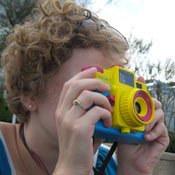Wednesday, November 25, 2009
Throughout our relationship, my boyfriend Mason and I have photographed our road trips and special dates with cheap disposable camera film. This tactic occasionally results in grainy and out-of-focus pictures, but it also consistently yields dazzling, comical images. Half the fun is waiting for the prints to be developed and consequently laughing at the inevitable photographic mishaps.
In this same spirit, this past summer we discovered the Holga, a cheap camera that was invented in 1982. These cameras were originally introduced in Hong Kong as photography entered mainstream popularity in Chinese culture. Western photographers discovered them soon after, and they became known worldwide for producing lush, unique images that are saturated with color and personality. Now distributed by the company Lomography (http://www.lomography.com), they are still prized for their potential and uniqueness.
Holgas are imperfectly produced on purpose, using plastic lenses and construction that, as the instruction book will tell you, occasionally falls apart. You can use everyday items such as tape and cardboard to keep the camera in working order and to prevent excessive light leaks on the film.
As far as the actual photography goes, it takes some practice working with the Holga to get the desired results, especially if you are used to automatic focus, automatic film advance or easily corrected digital photography. Still, the inevitable film disasters aren't the end of the world; they're just a laughable step in the learning process.
Once you get the hang of it, the resulting photos are brilliant, full of color and random light streaks. Though the images aren't perfect, they are chaotic by design, revealing facets of a moment that a pristine digital photo would never have captured.
1. Order your camera Holgas are available from Lomography, Amazon, Urban Outfitters, Veer and many other online shops. There are several simpler models, but I use the Holga 120CFN with a color flash for its versatility. You can purchase the camera alone for about $40; the starter kit retails for $70 and includes the camera, accessories, a soft-cover book of Holga images- ("The World Through A Plastic Lens," Lomography, 2006, $25), an instruction booklet, a poster, a roll of tape for sealing possible light leaks and a single roll of film. You can order the traditional black camera, but they also come in green, red and CMY (cyan, magenta and yellow). I have the CMYit makes a great fashion accessory.
2. Load your film You will need to load the film manually, so be sure the light is dim to avoid any damage to the exposures. The regular Holga takes 120mm medium-format film, which I purchase locally at Deville Camera and Video. Each roll of 12 exposures costs about $5. You can also buy different types of film directly from Lomography and other online retailers.
3. Start shooting The best place to start is outside under relatively bright-light conditions. The Holga has to be manually focused for your photos to appear clearly. Don't forget to take off the lens cap before you take pictures. In dimmer environments, you can change the camera's settings to let in more light.
4. Advance the film One of the Holga's unique, old-fashioned characteristics is its manual film advance. If you neglect to advance the film (unintentionally or otherwise) you will end up with hilarious doubly exposed images. It is fun to experiment with double exposures to see what odd juxtapositions you can create.
5. Experiment with flashes In lower-light situations, the Holga features a multi-colored flash option. You can choose the regular white flash or yellow, blue or red. Each different color interacts with the shot for a unique wash of color. If you are double-exposing the shot, you can try combining flashes. For example, yellow and blue will work for a green look.
6. Expose the film for different lengths of time If you are in a particularly low-light situation, you can change the exposure time from "N" to "B." The "N" setting will expose the film just briefly, but the "B" setting will expose it for as long as you hold down the shutter.
7. Develop your pictures Deville Camera and Video develops my pictures. It only takes a day or two to get them back. Each print costs about $1 for developing and printing. The cost prohibits me from indulging in Holga film and prints every week, and I do continue to use my digital camera for everyday use. It is worth it, however, to experiment with these beautiful images that capture distinctive moments on film.
8. Don't give up If your Holga shots don't turn out the way you hoped, keep trying. The next roll of film may turn out to be just what you were looking for. The Holga works best alongside a sense of humor and an delight in the unexpected.
HOLIDAY TIP:
Holga makes a great gift for your quirky, artsy friend or family member. Consider using a Holga to document holiday festivities or use Holga photos for holiday greeting cards.
